Back in the good old days of 1999, my dad and I used to go to a mom & pop store called Lazer Video (R.I.P.) to rent LaserDiscs, mainly so we could foolishly maintain the lie that our investment in state-of-the-art LaserDisc technology was not the next Betamax and was, indeed, the revolution. Needless to say, Lazer Video was dwindling, likely only held afloat by just me and my dad’s wallets alone, but they had so many great discs and, frankly, who else did? DVD hath spawned and there was to be a reckoning for all other media.
One particular summer night I was in the mood for a little gore and a little space so I thought, “let’s rent Alien: Resurrection.” My dad didn’t know anything about the Alien franchise so he kindly asked the Lazer Video employee for “Alien: Insurrection.” I smirked, Trek fan that I am, and regaled the employee with my fanfiction of what Alien: Insurrection would be about: mainly, aliens rebelling against a corrupt system trying to forcibly relocate Ripley and a group of androids. There were crickets.
Now, 20 years later, I actually see that happy accident of calling the film “Insurrection” kind of telling of what the filmmaking process was like for the production of Alien: Resurrection. Coming five years after the much-maligned and heavily edited Alien3 (as my associate Steve Wandling explains), Alien: Resurrection wasn’t exactly the hottest ticket item in town. In its opening weekend, Resurrection got trounced, by double digits, by Robin Williams’s Flubber while barely beating out the animated film Anastasia, which was in its third week of release.
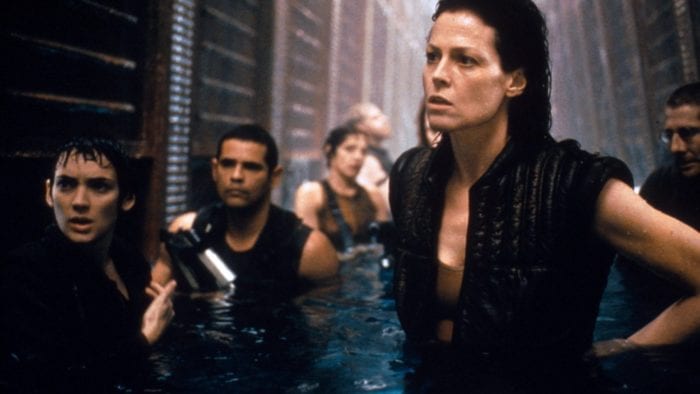
By week three, Alien: Resurrection was still getting dunked on by its mortal enemy Flubber but also the release of Scream 2 (okay, that makes sense), For Richer Or Poorer (uhhhh), Amistad (fair), and Home Alone 3 (wait, that was released theatrically?). While the worldwide box office haul was just enough to save the day overall for the studio, the film was met mostly with indifference and quite a few sneers.
But that is where the Insurrection reference comes into play. In keeping with the franchise’s tradition of delivering the unexpected in theme, scope, and (most importantly) directors, Alien: Resurrection was, in a sense, a revolt of the studio system, an about-face from the already flimsy canon of the then three-film franchise, and a cheeky grin to the burgeoning fan landscape that was growing with the rise of the World Wide Web.
Because, either in a vacuum, or taken only in hindsight of 1997, Alien: Resurrection was as subversive as it was divisive. Helmed by Jean-Pierre Jeunet, a Frenchman with horror chops and an eye for the weird, Alien: Resurrection basically went where no Alien film had gone before. It set itself hundreds of years after the last film, invented a new mythos, and redefined the xenomorph itself, down to its sexuality and, well, humanity.
In brief, Alien: Resurrection centers around a successful clone of Ellen Ripley (Sigourney Weaver), who was brought back to life using her “infected” DNA from Alien3, when she was carrying an Alien Queen inside her before she killed herself. Ripley has vague recollections of who she was in another life and body but is virtually an alien herself.
As one does in these movies, the Company (formerly Weyland-Yutani, now Wal-Mart…seriously) wants to use her DNA to create aliens and, if possible, concoct different species of creatures. While some enjoy the perverse science of it all (like Brad Dourif), others (like, who else, the military) want weapons. It all comes to a head when a group of space pirates led by Ron Perlman’s psychotic Johnner and undercover android Call (Winona Ryder) join Ripley’s vessel, delivering human cargo for the alien experiments. As expected, aliens get loose and the chase begins. During her escape, Ripley must figure out the meaning of her life, the existence of previously failed clones of her, and her biological duties (such as procreation) as a new form of life.
In 2019, it is hard to think of a major studio financing a known IP that explores and deconstructs the IP itself by asking, as well as depicting, uncomfortable subject matter while at the same time using primarily practical effects (there is not a lot of CGI in the film) on a relatively mid-to-low budget. Imagine if a Marvel film had Tony Stark finding out Thanos used Stark’s blood to try to replicate his brain structure and memories into a new body, then used Ebony Maw to conduct biological experiments that grafted Stark’s DNA and one of those four-legged dog things Thanos uses as cannon fodder to create a new form of life…and then Stark had sex with it?
Sure, the Alien films aren’t as culturally prevalent as the Marvel mythos in the zeitgeist, but it is still a known property with established characters. Did you, at any point, imagine Ripley would be protective of a xenomorph let alone let one impregnate her? Of course not! Jeunet dared to go there and took the rest of the franchise with him in what would be a one-off collision course with strangeness that scared executives so much, it took them seven years to try again, leading to the laziest and dumbest franchise turning point: Alien vs. Predator (or AVP if you care, which I don’t).
Let’s take a break and watch Brad Dourif doing Brad Dourif things in Alien: Resurrection.
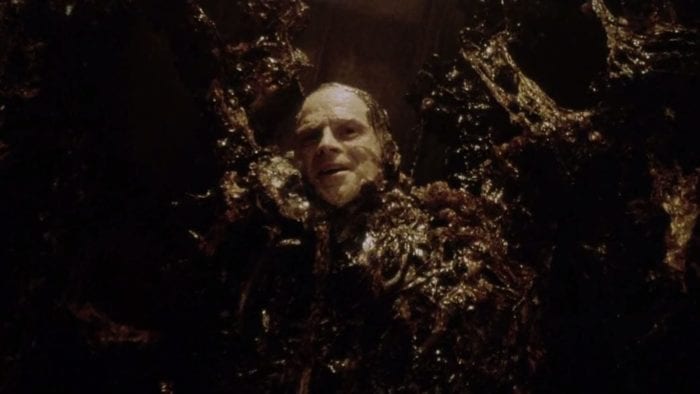
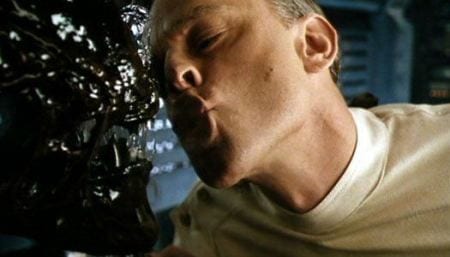
Okay, back to our regularly scheduled programming.
In today’s world, fan expectations are nearly impossible to mollify. If a studio or producer or director doesn’t take the product where the fans want, there is outrage. If the studio or producer or director takes a new direction with the product, there is outrage. If a certain path was laid out and a studio or producer or director suddenly takes a turn and goes somewhere else, there is outrage. You’re damned if you do (stick to the source material 100%, thus lacking originality) and damned if you don’t (veer from the source material, thus not being faithful to the product).
Alien: Resurrection was never held to 2019 standards of existence but, upon viewing, you could tell there was a sense of brand respect and consistency that falsely needed to be met. As previously mentioned, Aliens and Alien3 are vastly different films than Alien. Before Alien: Resurrection, the franchise consisted of a horror film, an action film, and a thriller. Resurrection attempted to be all three and more, and perhaps the mixture was just too much.
For the standard moviegoer, like my dad, the experience was too kaleidoscopic. One minute you’ve got Dan Hedaya picking out a piece of his brain and staring at it, the next a woman is getting the most orgasmic foot massage in film history, which then all leads to 45 minutes of Ron Perlman, a disabled Frenchmen in a tricked-out wheelchair, and that one dude from CSI doing awesome gun stunts and one-liners. So I get that response: weird, quirky, all-over-the-place cinema is tough for people just wanting to escape for two hours.
But the genre fan and knowledgeable filmgoer consensus seems to be that the film sucks, with a lot of complaints is that “it wasn’t the real Ripley” or “Aliens was better,” et cetera, et cetera. This film was never given the chance to exist on its own terms like the other 3 films in the franchise. Yes, being the third sequel to an all-time classic has its drawbacks, but Resurrection wasn’t doing anything differently than James Cameron and David Fincher were trying to do with their Alien films: tell a unique story using established characters and/or ideas.
On the technical side, I don’t think the film can be questioned for its brilliance. The production design by Nigel Phelps, art direction by Steve Cooper and Andrew Neskoromny, and set decoration by John M. Dwyer is excellent, evoking the existing universe established in the previous films but advancing them 200 years into the future, making the older things from the “used future” concept of Star Wars borrowed in the first Alien look older and the newer things look fittingly futuristic in contrast.
Aiding those people’s fine work is the breathtaking cinematography of Oscar-nominee Darius Khondji, whose use of light, shadows, depth, and smoke-saturated hallways evokes tension and confusion. The xenomorphs themselves, not to mention the human/alien hybrid later introduced, are mostly model design work (there is an underwater sequence where they are clearly ’90s CGI, which is unfortunate), and the design team adds steam to their skulls and breath and all matter of liquids and viscera to exude from their bodies.
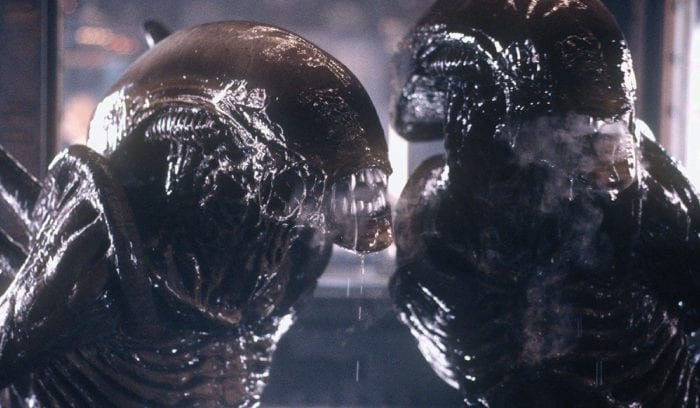
Add practical ship effects which, to me, is still the only way to go when depicting starships, and truly astounding stunt work (including an underwater chase sequence that was filmed with the real actors for weeks) and your production itself is top notch. Lastly, layering it all with dread and importance, is the score by John Frizzell: an especially haunting one, evoking the grandness of the Universal monster films of old where life was also experimented with, while playing with Jerry Goldsmith’s original theme in bits and pieces.
So it all must come down to a matter of taste, subject-wise. Alien: Resurrection rivals or surpasses its predecessors on the technical side, so what exactly rubbed people the wrong way? If it was the philosophical debate of man playing with nature, Ridley Scott would do the same years later in Prometheus and Alien: Covenant (also to mixed reviews). Could it be the movie’s mixture of bizarre humor and horrific action? It is hard to find a film that can make you chuckle and then gross you out a second later. Is it the subtle religious meaning of creating life and nurturing it? Is it just plain funky to see Sigourney Weaver get it on with a xenomorph?
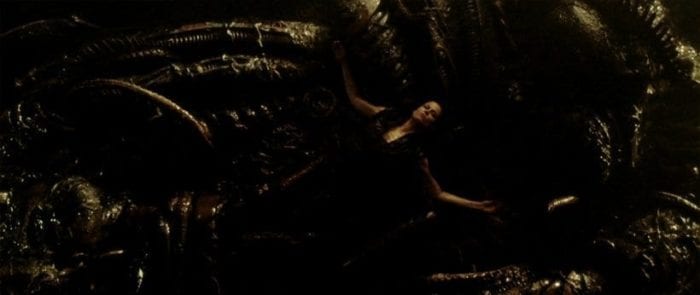
Something tells me it is all that and more. But, compared to what the franchise would briefly become with that Alien vs. Predator nonsense, at least Alien: Resurrection tried to say something—anything. None of the films up to that point forgot that the xenomorph itself is a prop for human stories, and Resurrection is the ultimate human story: what it means to be human and what someone (or something) created as partially human means for our existence. Aliens flirted with the concept of motherhood and natural protection instincts but that was against an Alien force. Resurrection takes that concept and runs with it, asking: what if the alien is us, literally and biologically?
Has it been a while since you saw it? Watch it again and share your opinions with me here. I was fortunate enough to see this on the big screen opening day and I’ve always had a soft spot for it (and still do, 22 years later). As the franchise itself continues to age, and film stories in general become more nuanced and advanced as the medium grows and mutates, I think Resurrection has aged better and better.



I recently re-watched this after discovering it was on Tubi, and darned if it might not be my favorite one. Don’t get me wrong, I’m not saying it’s better than the first or second films, it just kind of hooked me.
One of the strongest selling points is, of course, Sigourney Weaver. This new version of Ripley is still largely Ripley from the first three films, but a lot more edgy. She easily snarked as much as Goldblum did in “Jurassic Park,” but she was still entirely the heroine and you were of course behind her.
You can also tell while watching the film that Weaver herself is having fun playing this new twist on the Ripley character. She’s only sympathetic to a point, and she has a fun way of playing the tense scenes at the height of calm while allowing the rest of the cast to freak out around her. As Douriff’s character notes early on, there is something of a predator about her, and Weaver is quite literally having a ball playing that.
Ryder is maligned a lot in other reviews, but I liked her performance. Doe-eyed, and innocent, it’s interesting to watch the bond form between herself and Ripley, as both look human and act human (Maybe Ripley to a lesser extent) but neither is entirely human, giving them a connection neither has in any of the other characters. It’s also a nice call-back to see Ripley 8 being protective of Call, as she was with Newt in “Aliens,” but that she would have that type of instinct with a synthetic human.
They really come full-circle from the Ripley of “Aliens,” who was almost entirely distrusting of Bishop until the last act, and hated androids in general, to this cloned version of Ripley, who not only feels connected and has no animosity towards Call after her late revelation of being an android, unlike many of the others, but also sacrifices her alien “child,” in part because it’s threatening to kill Call in the film’s final act. It’s a move that is clearly emotionally devastating to Ripley 8, yet she makes it it anyway, saving Call in the process.
And while all the “Alien” films usually sport impressive supporting casts, (Although in “Alien,” many of them were still up-and-comers at the time) This one definitely manages to score the most eclectic, with the likes of Brad Douriff, perfect as the creepy scientist, Dan Hedaya, RON FCKING PERLMAN, and Michael Wincott. I wasn’t sure what to expect with Wincott, as I’ve seen him play a lot of OTT characters, but I was happy to see he played his role normal and restrained. J.E Freeman I wasn’t familiar with before the film, but he makes an excellent human baddie, same with Dominique Pinon, who is hilarious as the space pirate. Gary Dourdon sadly hasn’t sune much I’ve seen after this and CSI. Even Raymond Cruz and Leland Orser make the most of their even smaller supporting roles. You actually feel a twinge of sadness when both meet their respective demises.
Of all of them though, Ron Perlman was my favorite of the supports. He came across as a much more evil and unbalanced version of Duane Hicks. And the scene where Weaver puts him in his place and threatens to rip out his tongue, as well as the basketball scene, are hilarious. He’s an intimidating dude, yet Ripley believably schools him, much to our amusement.
The movie gets a bad rap. The effects are great and the music even better.
Joss Whedon famously said that his script was misfilmed, which might be true but Jeaunet brought his own distinct style to it.
The PlayStation game mentioned in the end credits is not bad either.